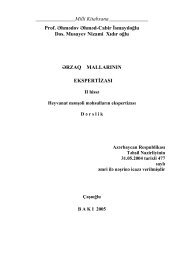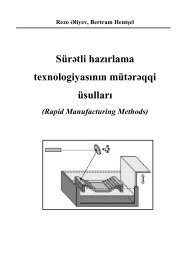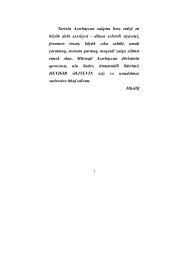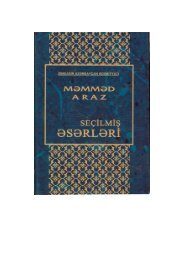XVIII yüzillik â XIX yüzilliyin ÉvvÉllÉrindÉ Osmanlı-AzÉrbaycan ...
XVIII yüzillik â XIX yüzilliyin ÉvvÉllÉrindÉ Osmanlı-AzÉrbaycan ...
XVIII yüzillik â XIX yüzilliyin ÉvvÉllÉrindÉ Osmanlı-AzÉrbaycan ...
Create successful ePaper yourself
Turn your PDF publications into a flip-book with our unique Google optimized e-Paper software.
Sheki, Gabala, Nakhchyvan, Ordubad, Maraga) voluntarely accepted the protection of Ottoman Empire.Ardebil, İrevan, Hamadan and other cities showed a desperate resistance.These cities were taken by storm. During the years from 1723 to 1725 Ottoman Empire occupiedabout 300 thousand sguare-km territories of the Safavies inheritance.İstanbul agreement did not remove the contradictions betwen Russia and Ottoman Empire accordingthe Caspian region, it merely eased them a little.Russian tsar regarded this treaty as temporary break and did not forget his plans about South Caucasus.Only after the death of Peter the İ in 1725, when under the conditions of weakning the centralizedpower his heirs understood the impracticality of Russia’s strengthening in the South Caucasus, theagressiveness of Russia in this region reduced. At the same time Russian government by all means triedto oppose the establishment of Ottomam İmpire at these lands; so, Russian government encouraged armeniansand georgians to stuggle against Ottomans.Ottoman Empire met the resistance of afghans striving to occupy all of the Safavies territories. Buthaving suffered a defeat in the battle with Ottoman turks near Hamadan, the leader of afghans Eshref,had to conclude a peace, treaty. According to the Khamadan peace treaty of 22-th September (3-rd ofOctober) in 1727 Eshref recognized the power of Turkey under the South Caucasus territories and alsoTabriz, Hamadan and Kirmanshah. One more faktor, which stained the Ottoman-Russian relationships,was the factor of indistinctness of border lines between the newly captured territories of two Empires.Only in December 12 (23) in the village Nabur near the Shemakha was drawn up a formal documentwhich finished the demarkation of the pointed territories on the newly occupied Azerbaijan lands.Ottoman government mainly preserved the administrative devisions and governing of Safavies timesmaking only some insignificant alterations. Borders of new provinces which were usually called“Sadgaks” in a certain extent corresponded to the borders of the former Safavies beylarbeys, but in somecases their size were decreased.The supreme military-administrative and also political power of provinces were concentrated inhands of the «serasker” or «muhafiz», who was appointed by the Sultan. Magal naibs and ketkhuds (villageforemen) were chosen from amount of local feudals.The Azeri lands to the North from the river Kura had their own special status. These territories wereruled by land owners, such were the Sheki, İlisy, Aresh. İn the central part of the former Shirvan beylerbeyexisted the half-independent Shirvan khanate. The appointment of Haji Davud on the chair of Shirvankhan appaled his former allies - Surkhay khan of Kazikumuk and uzmy Ahmed; for a long time theymade the pillage raids on Shirvan. Being dissatisfied with Haji Davud’s striving for independent actions,Ottoman government decided to relieve him of his post and to appoint instead of him Surkhay Khan. Sotrying to protect Shirvan from raids of mountain feudals Surkhay became the ruler of Shirvan in 1728.Ottoman ruling circles did not make any substantial changes in agrarian relations, only the lands oflocal feudals were confiscated. There were known such cases when Ottoman warriors, especiallyjanichars became owners of the lands in Azerbaijan.The character and main directions of social economical policy of Ottoman Empire were clearly displayedin the system of taxes. Having captured one or other district Ottomans put population census intoeffect, formed statutes with information about collecting taxes from population. From statutes it is seenthat Ottoman government was taking into consideration very hard living conditions of population andwith the aim of creation of conditions for economical revival temporarely stopped collecting some kindsof taxes, and some of taxes were completely abolished. Ottomans preserved the same forms of trade taxesand collections which existed in Safavies times. İn trade circulation were used simultaneously both, Safaviesand Ottoman monetary units. Together with that there were taken measures as regarded to revivalof trade. For instance with the aim of the widening silk trade transit across the Turkey there were collectedmore moderate customs. But it should be noted that in spite of the usually ordered tax collections,there were some cases of arbitrary ruling. The majority of funds, gathered by tax collecting, were allocatedto expenses for Ottoman army. Also much means were allocated to the fortification of strategic importantposts.İn spite of all Ottomans’ efforts they did not manage to stabilise the socio-economical situation inAzerbaijan. One of the most uneasy regions in territories occupied by Ottomans was the mountainouspart of Garabakh. İts population, mainly Christians united with living nearby Kurdish and Azerbaijanpeasants, and refused to pay taxes, organizing armed detachments and hiding in inaccessible places. Onlyin 1726 Ottoman to some extent were able to reach tranquillity in this region.166



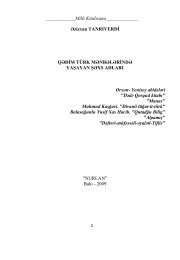
![H.Cavid dramaturgiyasında İnsan, İblis,Tanrı[Mətn] - Azərbaycan ...](https://img.yumpu.com/51530543/1/184x260/hcavid-dramaturgiyasnda-insan-iblistanrmtn-azrbaycan-.jpg?quality=85)
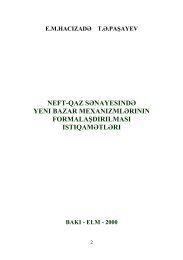
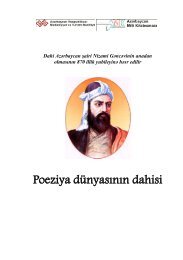

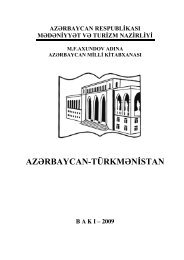
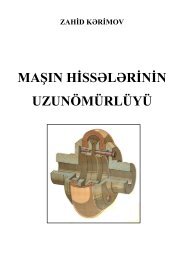

![HÉqiqÉt olduÄu kimi [MÉtn] - AzÉrbaycan Milli Kitabxanası](https://img.yumpu.com/50645082/1/184x260/heqiqet-olduau-kimi-metn-azerbaycan-milli-kitabxanasa.jpg?quality=85)
